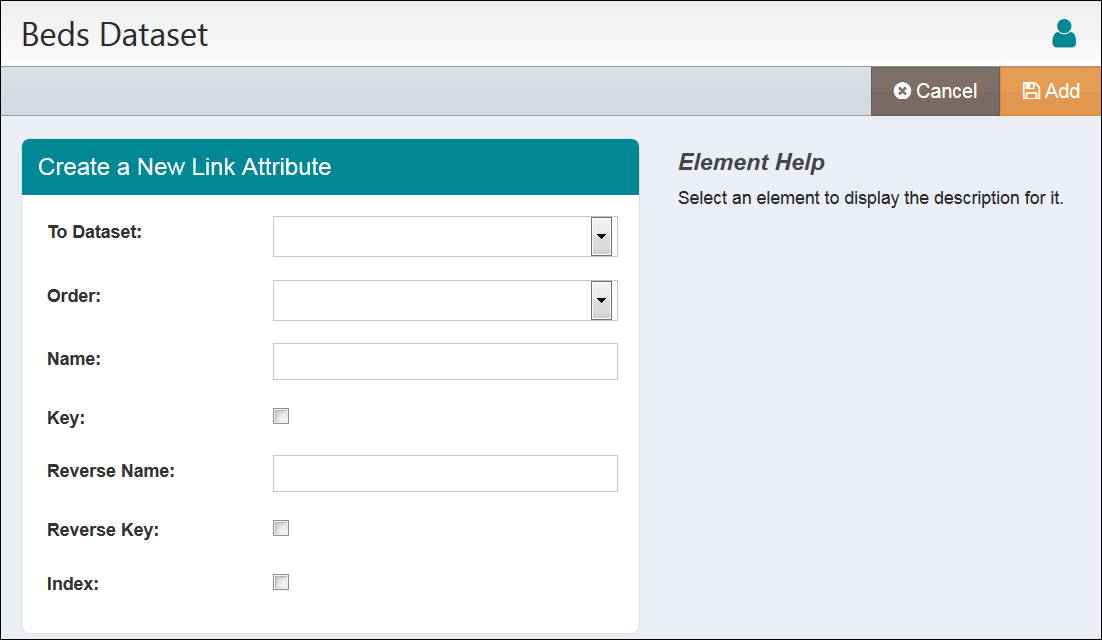Configure these dataset settings when creating a new link attribute, or editing an existing link attribute, in the Vocera system.
Access the Settings tab in the Vocera Platform Web Console to configure a new or existing link attribute. See Accessing Dataset Attributes.
-
Select the dataset where you wish to work with a link attribute, and expand the
Attributes tab.

-
Display the link attribute's configuration fields.
- Update Link Attribute: Click a link attribute name to display the Update Link Attribute dialog.
- Create a New Link Attribute: Select "Create a link" in the Attribute page to create a new linked attribute.

-
Complete the fields listed in the table below. An asterisk * indicates that the
field must be provided.
Name Description To Dataset * Select the dataset to which you are creating a link. For example, if you are working in a Beds dataset, you can link to the Assignments dataset to create a relationship between the two datasets. The options that appear in the drop-down menu will vary based upon your Vocera configuration. Once the link attribute is created, a navigable link displays in the starting dataset's Attributes table to access the linked 'To Dataset'. Order * Select the degree of association between the two datasets that the link should provide. For example, if you are working in Beds (starting dataset), you can create a link to Assignments (destination dataset) with one of the following associations. - One-to-one: Each member of the starting dataset can be linked to at most one member of the destination dataset, and each member of the destination dataset can be linked to at most one member of the starting dataset.
- One-to-many: Each member of the starting dataset can be linked to many members of the destination dataset, but each member of the destination dataset can be linked to at most one member of the starting dataset.
- Many-to-many: Each member of the starting dataset can be linked to many members of the destination dataset, and each member of the destination dataset can be linked to many members of the starting dataset.
- Many-to-one: Each member of the starting dataset can be linked to at most one member of the destination dataset, but each member of the destination dataset can be linked to many members of the starting dataset.
Name * Enter the name of this link for the starting dataset. The name must begin with a lowercase letter, contain no spaces, and it should be descriptive of the link's function. Key * Select the Key checkbox if this link is part of the key for the starting dataset. Note: If an attribute or link is created in the child of an abstract dataset, any attribute or link of the same name created in another child of the same abstract parent must also have the same type, Key, and required settings.Assigning the key value to an attribute allows the record associated with the attribute to be updated. If an attribute is not assigned a key value, the record cannot be updated; a new record will be created with the updated data that pertains to the attribute.Reverse Name * Enter the name of this link for the destination dataset. The name must start with a lowercase letter, contain no spaces, and it should be descriptive of the link's function. Reverse Key Select the Reverse Key checkbox if this link is part of the key for the destination dataset. Note: If an attribute or link is created in the child of an abstract dataset, any attribute or link of the same name created in another child of the same abstract parent must also have the same type, key, and required settings.Assigning the key value to an attribute allows the record associated with the attribute to be updated. If an attribute is not assigned the key value, it cannot be updated and a new record will be created for each piece of information that pertains to this attribute.Index Select the Index checkbox to create a custom index on the new attribute. This option is not available for key attributes, as they are indexed by design. Warning: Creating indexes can improve performance but can also adversely affect performance. Solutions packages will have the proper attributes already indexed. Adding indexes should be tested in a secondary environment to ensure no workflows are adversely affected. Consulting with support is recommended. -
When the configuration is complete, select the appropriate option to complete
the new or existing link attribute.
- Add: Create the new link attribute in the system.
- Update: Update the existing link attribute. Only the Index and Additional Actions configuration fields can be modified.
- Cancel: Return to the dataset page without making a change.
-
The new or revised link attribute will display a success message to confirm
your changes.

